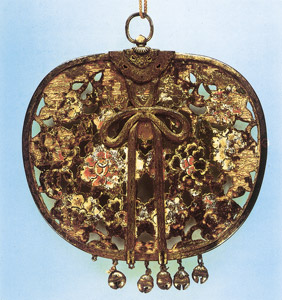本文
Coloured wooden openwork keman (stylized Buddhist hanging ornament) carved with a chrysanthemum and peony motif. With black lacquered box
Coloured wooden openwork keman (stylized Buddhist hanging ornament) carved with a chrysanthemum and peony motif. With black lacquered box

Nationally Designated Important Cultural Property (designated 1969)
Made: Kōō 1, 1389
Kōbōji temple, Senzu, Ushimado
Dimensions: 30.5×34.6cm
A type of Buddhist ornament usually hung from a beam in a temple’s main hall, keman are said to derive from the garlands that were offered to nobles in ancient India.
A note written on the bottom of the lacquered box containing this keman records that it was made in 1389. Various techniques have been employed to realise the keman’s many beautiful artistic features. The carved openwork chrysanthemum, peony, and arabesque motifs have been covered with black lacquer and then painted with white pigment as a foundation. Over this, red, green, and blue pigments have been used to add colour. Also attached are a variety of gilt-bronze embellishments, including a border, pendant loop, ribbon ornaments, and bells.





